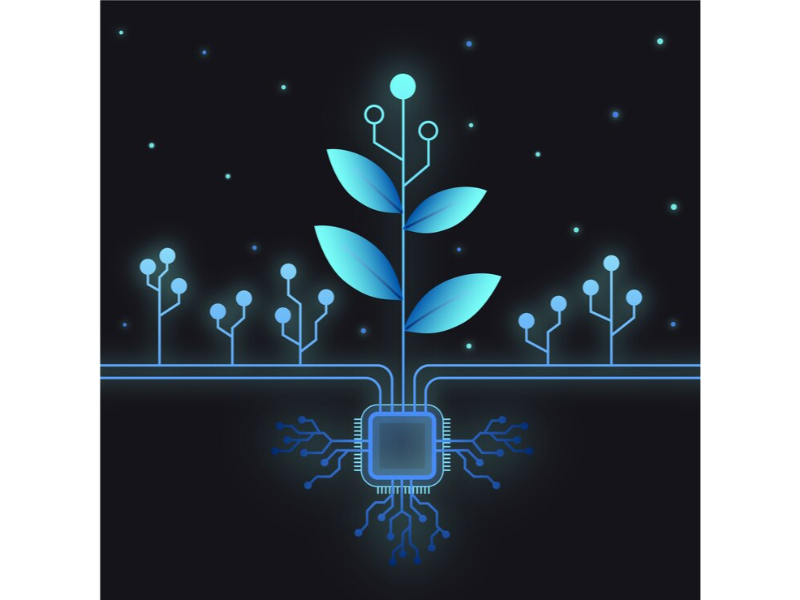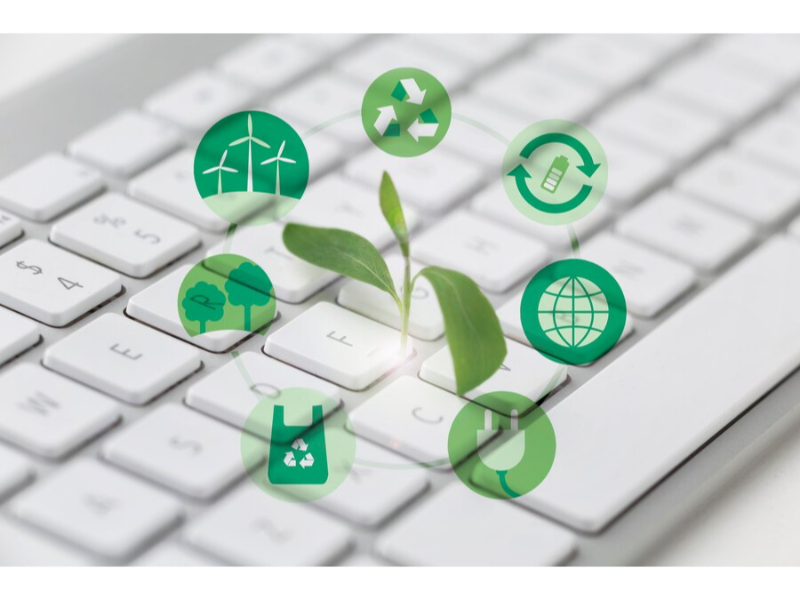- Green technology is transforming IT infrastructure with energy-efficient innovations and renewable energy integration.
- These advancements are reshaping data centers, e-waste management, and sustainable computing to combat climate change.
Sustainability is no longer a niche topic—it is now a global priority. The IT sector, often seen as a driver of innovation, has traditionally been energy-intensive, contributing significantly to global carbon emissions. However, this narrative is rapidly changing with the rise of green technology in IT infrastructure. From renewable energy-powered data centers to AI-driven energy optimization tools, IT companies are leading the way in integrating sustainability into their operations.
The rise of cloud computing, big data, and artificial intelligence has increased the demand for IT infrastructure, making the need for sustainable practices more urgent. According to the International Energy Agency (IEA), data centers consume nearly 1% of global electricity. Without intervention, this figure could rise exponentially as technology advances. To combat this, IT giants and startups alike are rethinking infrastructure to align with environmental goals.
Green IT is not just about reducing emissions; it’s about redefining how businesses interact with technology while ensuring environmental resilience.
Understanding green technology in IT
Green technology in IT refers to the use of sustainable practices and eco-friendly tools in developing, deploying, and maintaining IT infrastructure. This approach focuses on minimizing the environmental impact while maintaining optimal performance. It encompasses the following key areas:
- Energy efficiency: Reducing energy consumption through innovative designs and operational strategies.
- Renewable energy integration: Powering data centers and infrastructure with solar, wind, or hydropower.
- Sustainable hardware: Developing recyclable and biodegradable components to minimize e-waste.
- E-waste management: Implementing strategies to recycle or responsibly dispose of outdated IT equipment.
IT infrastructure can be both powerful and sustainable. Green technology ensures that progress does not come at the cost of our planet.
Emily Zhang, Director of Sustainable IT Practices at EcoCompute Labs

The role of IT infrastructure in achieving carbon neutrality
IT infrastructure is a cornerstone of modern life, supporting everything from banking to streaming services. However, it also contributes significantly to greenhouse gas emissions. Data centers, the backbone of IT infrastructure, require immense energy to power servers and cooling systems.
Here’s how green technology is addressing these challenges:
- Energy-optimized cooling systems
Cooling systems in data centers account for nearly 40% of their energy consumption. Liquid immersion cooling, a revolutionary approach, submerges servers in a cooling fluid, reducing power usage and operational costs. - Renewable energy adoption
Companies like Microsoft, Google, and Amazon are switching to renewable energy to power their data centers. Google, for example, achieved 100% renewable energy usage across its operations in 2020. - AI for energy management
Artificial intelligence optimizes energy distribution by analyzing patterns and automating processes. AI-driven tools ensure that power is allocated efficiently, reducing waste and lowering operational expenses. - Biodegradable components
Sustainable hardware is gaining traction. Companies are investing in circuit boards made from natural fibers, which decompose without harming the environment.
Innovations driving green IT forward
Green technology is transforming IT infrastructure through cutting-edge innovations. Here are some of the most promising developments:
1. Liquid immersion cooling
Liquid immersion cooling is replacing traditional air-based systems. Servers submerged in cooling liquid dissipate heat more efficiently, cutting energy costs by 20-30%. This method also extends server life, reducing the need for frequent replacements.
2. Modular data centers
Modular data centers are pre-assembled, energy-efficient units that can be deployed quickly. These systems are optimized for renewable energy usage and can scale with business needs.
3. Smart grids for IT infrastructure
Smart grids integrate IT infrastructure with renewable energy sources, ensuring energy is used optimally. These systems enable real-time monitoring and energy distribution adjustments.
Green IT is a win-win. It benefits the environment while reducing long-term operational costs.
Ravi Mehta, Sustainability Consultant at GreenTech Advisors
Also read: Sustainable tech solutions: Biodegradable Electronics
Barriers to green technology adoption
Despite its potential, green technology in IT infrastructure faces several challenges:
- High initial costs
The upfront costs of implementing green solutions, such as renewable energy systems or liquid cooling, can be prohibitive for small and mid-sized businesses. - Integration with legacy systems
Many organizations rely on outdated infrastructure that isn’t compatible with green technologies. Retrofitting these systems is often complex and expensive. - Knowledge gaps
There is a shortage of expertise in green IT, making it difficult for organizations to adopt sustainable practices effectively. - Global energy policy variations
Differences in energy regulations and renewable energy availability complicate global adoption of green IT solutions.

Also read: EU approves law to boost domestic green tech production
Pop quiz
What is the primary benefit of modular data centers?
A. Lower cooling costs
B. Scalability and energy efficiency
C. Faster internet speeds
D. Reduced hardware prices
The correct answer is at the bottom of the article.
The financial benefits of green IT
Investing in green IT is not just good for the environment; it makes business sense too. Here’s how:
- Reduced operational costs
Energy-efficient systems and renewable energy adoption lower utility bills. Microsoft, for instance, reported a 15% drop in energy expenses after introducing AI-powered cooling. - Tax incentives
Governments around the world offer tax credits and grants to businesses investing in green technology. - Attracting environmentally conscious customers
Consumers are increasingly favoring companies that demonstrate environmental responsibility. Green IT enhances brand reputation and customer loyalty. - Avoiding penalties
Stringent environmental regulations are being enforced globally. Adopting green IT ensures compliance, avoiding fines and legal issues.
Green IT in action: Real-world examples
1. Google’s renewable data centers
Google has been a leader in green IT, powering its data centers with 100% renewable energy. By integrating AI-driven tools, the company optimizes energy usage, making its operations highly efficient.
2. Dell’s circular economy model
Dell runs a take-back program that recycles old devices into new products. This initiative minimizes e-waste while reducing the need for raw materials.
3. Amazon’s sustainable hardware
Amazon’s hardware products incorporate recycled materials, aligning with the company’s Climate Pledge to reach net-zero carbon by 2040.

Also read: Singapore unveils Green Data Centres for a sustainable future
Future trends in green technology
As technology advances, the future of green IT looks promising. Here are some trends shaping the industry:
1. Carbon-neutral cloud computing
Cloud providers are focusing on carbon-neutral data centers to offer sustainable services.
2. Energy-efficient AI models
AI systems are being redesigned to consume less energy during training and deployment.
3. Green blockchain
Energy-efficient blockchain platforms are being developed to minimize the environmental impact of cryptocurrency mining.
4. Decentralized energy grids
Decentralized grids integrate renewable energy sources, allowing businesses to generate and manage their energy locally.
Also read: Solar-powered aircraft: The green future of flight
Green technology is revolutionizing IT infrastructure, making it more sustainable and efficient. From liquid cooling to AI-powered energy management, these innovations are setting the stage for a greener future.
While challenges persist, the financial and environmental benefits of green IT far outweigh the initial investments. By adopting sustainable practices, businesses not only reduce their carbon footprint but also position themselves as leaders in a rapidly changing industry.
As governments and consumers demand greater accountability, the adoption of green IT will continue to grow, paving the way for a sustainable digital economy.
Green IT involves sustainable practices in IT operations, including energy efficiency, renewable energy adoption, and minimizing e-waste.
It reduces carbon emissions, enhances energy efficiency, and ensures compliance with environmental regulations.
High initial costs, integration with legacy systems, and knowledge gaps are major barriers.
Liquid immersion cooling, AI-powered energy management, and biodegradable hardware are some of the key innovations.
It lowers operational costs, improves brand reputation, and ensures compliance with environmental laws.
Quiz answer
B. Scalability and energy efficiency
